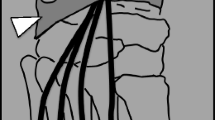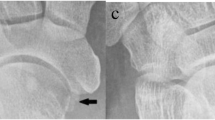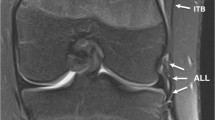Abstract
Objective
To describe a distinct constellation of MRI demonstrated soft tissue abnormalities centred around the tibialis anterior tendon in a subset of patients presenting as suspected tibial stress injury.
Materials and methods
A retrospective review was performed of the clinical and MRI imaging findings from 5 selected patients referred for MRI with suspected tibial stress injury. MRI studies at presentation of each case were systematically reviewed for peritendinous fluid, tibialis anterior tendon change, tibialis anterior muscle and myotendinous junction oedema, periosteal oedema over the tibia and tibial marrow oedema.
Results
All 5 cases were athletes (3 soccer players, 2 runners) of between 20 and 40 years of age. On MRI, all 5 cases demonstrated peritendinous fluid around an intact tibialis anterior tendon. This fluid was maximal at the junction of mid and distal thirds of the lower leg, and extended down to the superior extensor retinaculum, with a mean cranio-caudal length of 13 cm (range 8–17 cm). Associated oedema was present in the surrounding subcutaneous tissue, tibial periosteum and distal tibialis anterior musculotendinous junction.
Conclusion
Peritendinous fluid around an intact tibialis anterior tendon over the mid-to-distal third tibia, with surrounding subcutaneous, periosteal and tibialis anterior myotendinous junction oedema is demonstrable on MRI in a subset of patients presenting as suspected tibial stress injury. A friction syndrome of tibialis anterior between the superior extensor retinaculum and the anterior tibia is proposed as the aetiology of this entity.


Similar content being viewed by others
References
Matheson GO, Clement DB, Mckenzie DC, Taunton JE, Lloyd-Smith DR, Macintyre JG. Stress fractures in athletes: a study of 320 cases. Am J Sports Med. SAGE Publications Inc STM. 1987;15:46–58.
Gaeta M, Minutoli F, Scribano E, Ascenti G, Vinci S, Bruschetta D, et al. CT and MR imaging findings in athletes with early Tibial stress injuries: comparison with bone scintigraphy findings and emphasis on cortical abnormalities. Radiology Radiological Society of North America. 2005;235:553–61.
Kijowski R, Choi J, Mukharjee R, de Smet A. Significance of radiographic abnormalities in patients with tibial stress injuries: correlation with magnetic resonance imaging. Skelet Radiol. 2007;36:633–40.
Fredericson M, Bergman AG, Hoffman KL, Dillingham MS. Tibial stress reaction in runners: correlation of clinical symptoms and scintigraphy with a new magnetic resonance imaging grading system. Am J Sports Med. 1995;23:472–81.
Kijowski R, Choi J, Shinki K, Del Rio AM, De Smet A. Validation of MRI classification system for tibial stress injuries. Am J Roentgenol. American Roentgen Ray Society. 2012;198:878–84.
Lee MH, Chung CB, Cho JH, Mohana-Borges AV, Pretterklieber ML, Trudell DJ, et al. Tibialis anterior tendon and extensor retinaculum: imaging in cadavers and patients with tendon tear. Am J Roentgenol American Roentgen Ray Society. 2006;187:W161–8.
Anagnostakos K, Bachelier F, Fürst OA, Kelm J. Rupture of the anterior tibial tendon: three clinical cases, anatomical study, and literature review. Foot Ankle Int. SAGE Publications Inc. 2006;27:330–9.
Numkarunarunrote N, Malik A, Aguiar RO, Trudell DJ, Resnick D. Retinacula of the foot and ankle: MRI with anatomic correlation in cadavers. Am J Roentgenol. 2007;188:W348–54.
Varghese A, Bianchi S. Ultrasound of tibialis anterior muscle and tendon: anatomy, technique of examination, normal and pathologic appearance. J Ultrasound. 2014;17:113–23.
Gwynne-Jones D, Garneti N, Wyatt M. Closed tibialis anterior tendon rupture: a case series. Foot Ankle Int. SAGE Publications Inc. 2009;30:758–62.
Palmer W, Bancroft L, Bonar F, Choi J-A, Cotten A, Griffith JF, et al. Glossary of terms for musculoskeletal radiology. Skelet Radiol. 2020;49:1–33.
Sammarco GJ, Cooper PS. Flexor hallucis longus tendon injury in dancers and nondancers. Foot Ankle Int SAGE Publications Inc. 1998;19:356–62.
Mubarak SJ, Gould RN, Lee YF, Schmidt DA, Hargens AR. The medial tibial stress syndrome: a cause of shin splints. Am J Sports Med. 1982;10:201–5.
Moen MH, Tol JL, Weir A, Steunebrink M, De Winter TC. Medial tibial stress syndrome: a critical review. Sports Med Auckl NZ. 2009;39:523–46.
Author information
Authors and Affiliations
Corresponding author
Ethics declarations
Conflict of interest
The authors declare no competing interests.
Additional information
Publisher’s note
Springer Nature remains neutral with regard to jurisdictional claims in published maps and institutional affiliations.
Rights and permissions
About this article
Cite this article
Kho, J.S.B., Botchu, R., Rushton, A. et al. MRI findings of tibialis anterior friction syndrome: a mimic of tibial stress injury. Skeletal Radiol 50, 2007–2011 (2021). https://doi.org/10.1007/s00256-021-03756-1
Received:
Revised:
Accepted:
Published:
Issue Date:
DOI: https://doi.org/10.1007/s00256-021-03756-1




